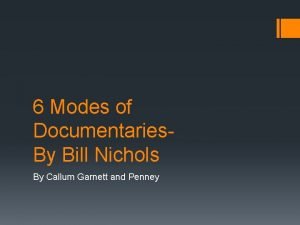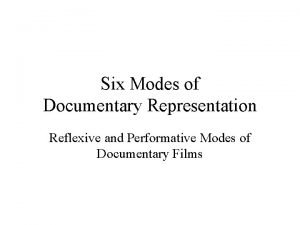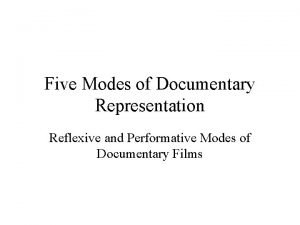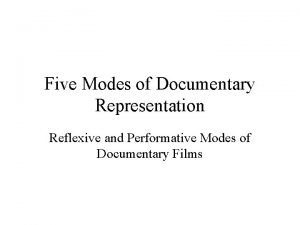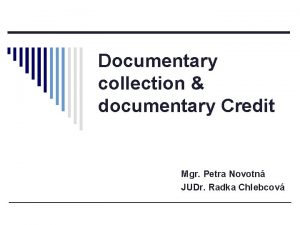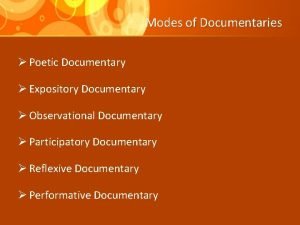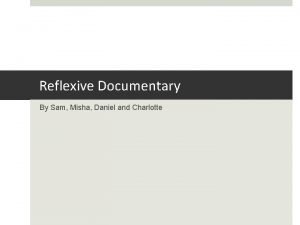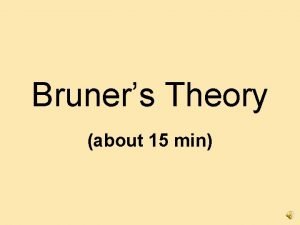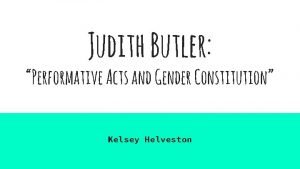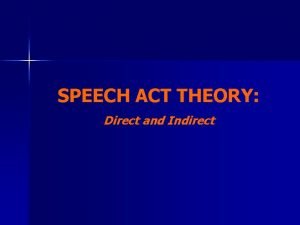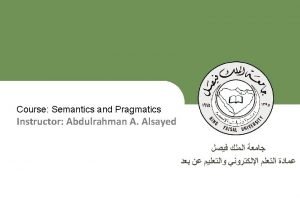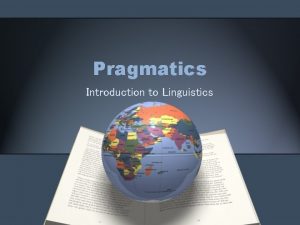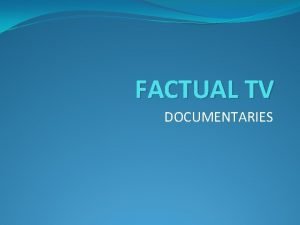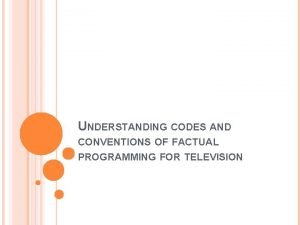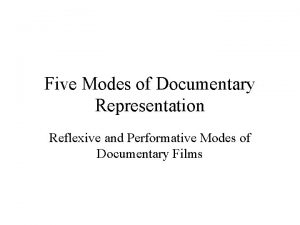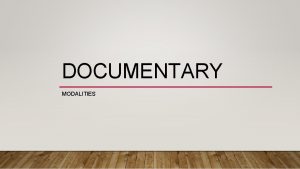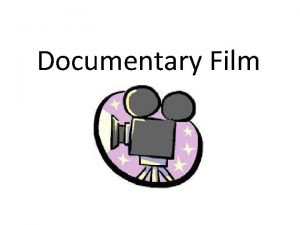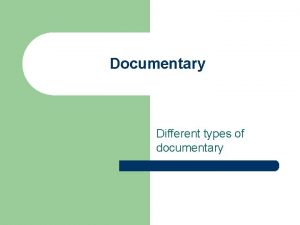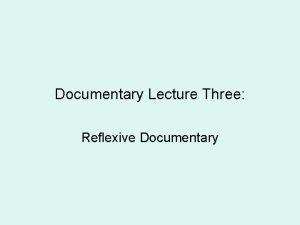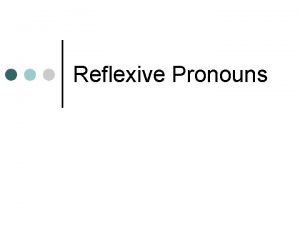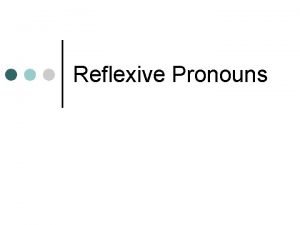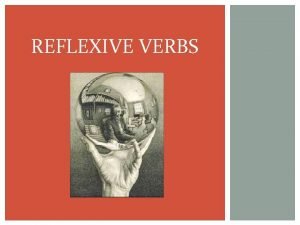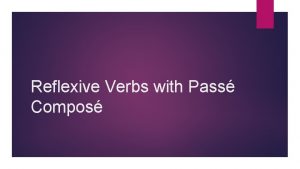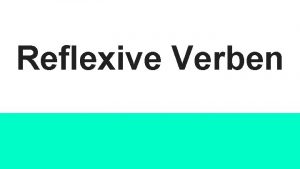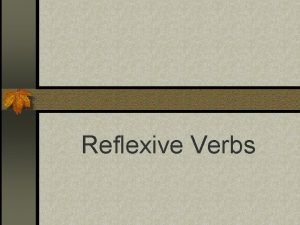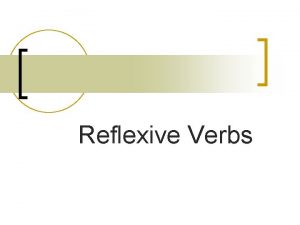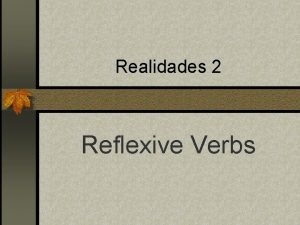Six Modes of Documentary Representation Reflexive and Performative















![Performative Mode ‘ [Performative documentaries] stress subjective aspects of a classically objective discourse [documentaries] Performative Mode ‘ [Performative documentaries] stress subjective aspects of a classically objective discourse [documentaries]](https://slidetodoc.com/presentation_image/54d63251407fc7a56995e16b50c897b5/image-16.jpg)





- Slides: 21

Six Modes of Documentary Representation Reflexive and Performative Modes of Documentary Films

1) Reflexive Mode of Documentary Representation 2) Dziga Vertov and Man with a Movie Camera 3) Performative Mode of Documentary Representation 4) Chris Maker’s Sans soleil

Reflexive Mode ‘Reflexive documentary arose from a desire to make the conventions of representations themselves more apparent and to challenge the impression of reality which the other three modes normally conveyed unproblematically. ’ Bill Nichols, Representing Reality

Reflexive Mode • To problematize the ways in which documentaries reveal the truth • Reflexive documentaries are about documentaries, documentary representation and documentary film making. • Meta-documentary - a documentary about documentary SELF-REFLEXIVE

Dziga Vertov • Dziga Vertov (18961954) psychoneurologist, film editor, director and theorist • Formation of the group of filmmakers called ‘Kinok’ (or ‘Kino-oki’) = camera eye

Dziga Vertov • Vertov and ‘Kino-oki’ abandons fiction film for documentary. • Films about film, and how film functions and filmmaking operates. • The camera’s versatility and special ability to capture life-asit-is which is missed by human eye. • The film drama is the opium of the people… down with Bourgeois fairy-tale scenarios… long live life as it is!

Dziga Vertov’s idea of film realism • Belief in the primacy of movie camera over human eye - To be able to see at long distances, to film in slow or fast motion, etc. - Through editing, scenes from different times and places could be put together, the same scene viewed from several different angles, impressions of speed and energy enhanced by fast cutting • Machines can see reality better and technologies can record it better than human beings – reflection on filmmaking

• Kinok (Kino-oki) presents a reality which only a movies can presents. • The reality different from the reality the audience knows. • Thus, Vertov’s film poses a question: ‘Is the reality captured in his documentary a reality? ’ • His reality does not agree with our idea of. Dziga Vertov

Dziga Vertov ‘Our eyes see very little and very badly – so people dreamed up the microscope to let them see invisible phenomena; they invented the telescope… now they have perfected the cinecamera to penetrate more deeply into the visible world, to explore and record visual phenomena so that what is happening now, which will have to be taken account of in the future, is not forgotten. ’ Provisional Instructions to Kino-Eye Groups, Dziga Vertov, 1926

Dziga Vertov • Man with a Movie Camera (1929) presents urban lives in Soviet cities. From dusk to dawn Soviet citizens are shown at work and at play. • Also, it is about film making.

Man with a Movie Camera • Showing the viewer how a film is made by way of: - Double exposure - Quick motion - Slow motion - Stop motion - Tracking shot - Extreme high and low angles - Unusual camera movement

Dziga Vertov

Errol Morris • The Thin Blue Line (1988) - a documentary about Randall Adams who was convicted and sentenced to a life imprisonment for the murder of a police officer. • The film relies on the conventions of interactive documentary - interviews and confessions.

Errol Morris • Tension arises when statements contradict each other and this draws our attention to the legitimacy of testimonies and confessions recorded in the documentary. • Randall Adams swears he did not kill the policeman but competing statements are presented. • Despite the quest for evidence, the film underlies the uncertainty of what evidence there is.

Errol Morris • Morris use reconstructions, which are a taboo in observational and interactive, or any documentary. • Reconstructions to present controversial version of the events, exposing inconsistencies in the evidence against Adams and also provoking a debate on the reliability of the documentary. • Uncertainty whether we can trust or believe documentary.
![Performative Mode Performative documentaries stress subjective aspects of a classically objective discourse documentaries Performative Mode ‘ [Performative documentaries] stress subjective aspects of a classically objective discourse [documentaries]](https://slidetodoc.com/presentation_image/54d63251407fc7a56995e16b50c897b5/image-16.jpg)
Performative Mode ‘ [Performative documentaries] stress subjective aspects of a classically objective discourse [documentaries] - possible limitations: loss of referential emphasis may relegate such films to [the] avant-garde [fiction films]; ‘excessive’ use of style. ’ Bill Nichols, Blurred Boundaries

Performative Mode • The priority - to evoke the MOOD or ATMOSPHERE • The filmmaker constructs subjective ‘truths’ that are significant to him or herself. • Presentation of reality in a subjective, expressive, stylized, evocative and visceral manner. • Deeply personal, it tells filmmaker him- or herself’s stories, experiences, concerns, preoccupations, and thought.

• Alain Resnais’s Nuit et Brouillard (Night and Fog, 1955) • One of the first documentaries on the horror of the Holocaust.

Performative Mode • Contrast between the huge stillness of the abandoned camps and horrific wartime footage. • Texts by Jean Cayrol and spoken by Michel Bouquet with music by Bertolt Brecht’s music composer, Hanns Eisler. nuit et bruillard

• Chris Maker, Sans soleil (1983) • Meditations on travel, memory (or forgetting), and time in words and images.

• An essay, collage of images literary comments and philosophical reflection, and creating an atmosphere of dream.
 Bill nichols modes of documentary
Bill nichols modes of documentary Performative documentary
Performative documentary Performative mode
Performative mode What is a reflective documentary
What is a reflective documentary Reflexive mode
Reflexive mode Clean collection vs documentary collection
Clean collection vs documentary collection Documentary collection vs documentary credit
Documentary collection vs documentary credit Poetic documentary conventions
Poetic documentary conventions Misha daniel
Misha daniel Bruner's modes of representation
Bruner's modes of representation Judith butler performative acts and gender constitution
Judith butler performative acts and gender constitution Classify each polygon
Classify each polygon Theory in a sentence
Theory in a sentence Autsin butler
Autsin butler Examples of utterances
Examples of utterances Expressive speech act
Expressive speech act What is pragmatics in linguistics
What is pragmatics in linguistics Documentary conventions
Documentary conventions The uniform customs and practice for documentary credits
The uniform customs and practice for documentary credits Documentary codes and conventions
Documentary codes and conventions Documentary codes and conventions
Documentary codes and conventions Compositional modes for social media
Compositional modes for social media
